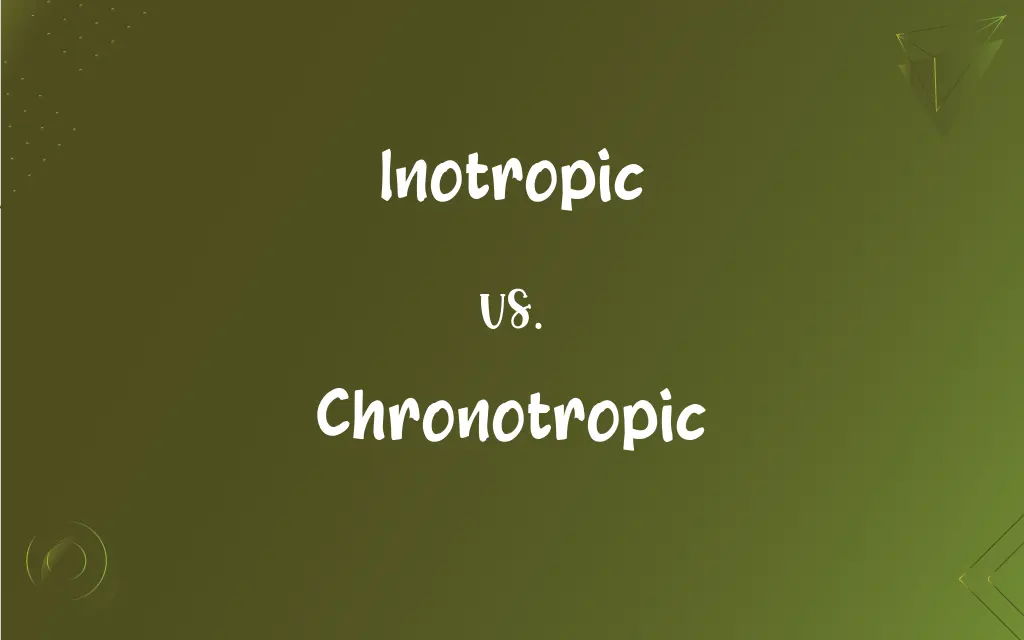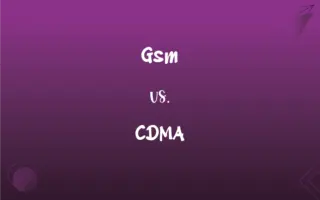Inotropic vs. Chronotropic: What's the Difference?
Edited by Janet White || By Harlon Moss || Updated on October 3, 2023
Inotropic relates to the force of muscle contraction; chronotropic relates to heart rate.

Key Differences
Inotropic and chronotropic are terms frequently used in cardiology to describe different physiological aspects of the heart. The inotropic state refers to the strength or force of the heart's contractions. Chronotropic, on the other hand, pertains to the heart rate or the rhythm of the heartbeat.
While both inotropic and chronotropic deal with the heart, they are distinct in their references. Inotropic agents, for example, are drugs that can either increase or decrease the force of heart contractions. Chronotropic agents, in contrast, influence the heart rate, either accelerating or decelerating it.
Assessing both inotropic and chronotropic functions is crucial in various medical scenarios. If a patient presents with a weakened heart contraction, an inotropic effect might be needed. However, if the primary concern is an irregular or abnormally fast/slow heartbeat, a chronotropic effect would be targeted.
It's essential to understand the balance between inotropic and chronotropic factors. For instance, a drug may have a positive inotropic effect (increasing contraction strength) but a negative chronotropic effect (decreasing heart rate). Similarly, some conditions might negatively influence both the inotropic and chronotropic states of the heart.
In summary, while inotropic and chronotropic both concern the heart, the former deals with the force of contractions, and the latter addresses the heart rate.
ADVERTISEMENT
Comparison Chart
Basic Definition
Refers to force of muscle contraction.
Refers to heart rate.
Impact on Heart
Affects the strength of heart contractions.
Affects the rhythm or speed of the heartbeat.
Related Agents
Drugs can increase or decrease contraction force.
Drugs can increase or decrease heart rate.
Example Diseases
Cardiomyopathy impacts inotropic function.
Arrhythmias impact chronotropic function.
Clinical Importance
Vital for assessing heart’s pumping efficacy.
Essential for rhythm and regularity of heart.
ADVERTISEMENT
Inotropic and Chronotropic Definitions
Inotropic
Pertaining to the strength of muscular contractions.
The inotropic state of his heart was compromised due to disease.
Chronotropic
Pertaining to the speed of heart contractions.
Chronotropic medications can regulate an irregular heartbeat.
Inotropic
Indicative of the contractility of heart muscles.
They assessed both the inotropic and rhythmic functions of the patient's heart.
Chronotropic
Describing agents that impact heart rate.
Given his tachycardia, they considered a negative chronotropic drug.
Inotropic
Relating to the force of heart contractions.
The drug had a positive inotropic effect, strengthening the heart's contractions.
Chronotropic
Distinguishing the rate aspect from the force in cardiac function.
The chronotropic function was stable, but there were concerns about contractility.
Inotropic
Differentiating the force aspect from the rhythm in cardiac function.
While the rhythm was regular, the inotropic function needed support.
Chronotropic
Signifying the regularity and speed of heartbeats.
With age, the chronotropic competence of the heart can decrease.
Inotropic
Used to describe agents that influence contraction force.
Doctors prescribed an inotropic medication to help her heart.
Chronotropic
Referring to the heart rate or rhythm.
The medicine had a negative chronotropic effect, slowing down his heartbeat.
Inotropic
Affecting the contraction of muscle, especially heart muscle
An inotropic drug.
Chronotropic
(physiology) Of, relating to, or affecting the rate of muscular contraction, especially of the heart.
Inotropic
(physiology) Increasing or decreasing the force of muscular contractions.
Inotropic
An inotropic heart drug.
FAQs
Are there negative inotropic effects?
Yes, negative inotropic effects decrease the force of heart contractions.
How does a positive chronotropic effect manifest?
A positive chronotropic effect increases the heart rate.
What could cause compromised inotropic function?
Conditions like cardiomyopathy can impact inotropic function.
Why is chronotropic function important?
Chronotropic function is essential for the rhythm and regularity of the heart.
Can an inotropic effect influence blood pressure?
Yes, since inotropic effects impact heart contraction strength, they can influence blood pressure.
What might a doctor prescribe for irregular chronotropic function?
A doctor might prescribe chronotropic agents to regulate an irregular heartbeat.
How are chronotropic effects measured?
Chronotropic effects can be measured using heart rate monitors or electrocardiograms (ECGs).
Why is understanding the difference between inotropic and chronotropic significant in medicine?
It helps healthcare professionals accurately diagnose, treat, and manage heart-related conditions.
How do inotropic agents work?
Inotropic agents work by either increasing or decreasing the force of heart contractions.
Can age impact inotropic function?
Yes, age can reduce the heart's inotropic efficiency, affecting its pumping ability.
How does stress relate to chronotropic function?
Stress can induce a positive chronotropic effect, increasing heart rate.
Can a drug be both inotropic and chronotropic?
Yes, some drugs can have both inotropic (affecting contraction strength) and chronotropic (affecting heart rate) effects.
Are inotropic and chronotropic terms limited to cardiology?
While primarily used in cardiology, they can be applied to other muscular contractions as well.
Are there diseases that affect only the inotropic function?
Some diseases primarily affect inotropic function, but they may have secondary effects on chronotropic function as well.
Can lifestyle changes improve inotropic function?
Yes, healthy lifestyles, including diet and exercise, can support and improve inotropic function.
What does inotropic mean?
Inotropic refers to the force or strength of muscle contractions, especially in the heart.
Are chronotropic effects always desirable?
No, undesired chronotropic effects can lead to arrhythmias or other heart-related issues.
What is the significance of chronotropic?
Chronotropic pertains to the heart rate or the rhythm of the heartbeat.
Why is a balance between inotropic and chronotropic effects crucial?
A balance ensures that the heart pumps efficiently and maintains a healthy rhythm.
Can exercise impact chronotropic function?
Yes, exercise typically induces a positive chronotropic effect, increasing heart rate.
About Author
Written by
Harlon MossHarlon is a seasoned quality moderator and accomplished content writer for Difference Wiki. An alumnus of the prestigious University of California, he earned his degree in Computer Science. Leveraging his academic background, Harlon brings a meticulous and informed perspective to his work, ensuring content accuracy and excellence.
Edited by
Janet WhiteJanet White has been an esteemed writer and blogger for Difference Wiki. Holding a Master's degree in Science and Medical Journalism from the prestigious Boston University, she has consistently demonstrated her expertise and passion for her field. When she's not immersed in her work, Janet relishes her time exercising, delving into a good book, and cherishing moments with friends and family.































































